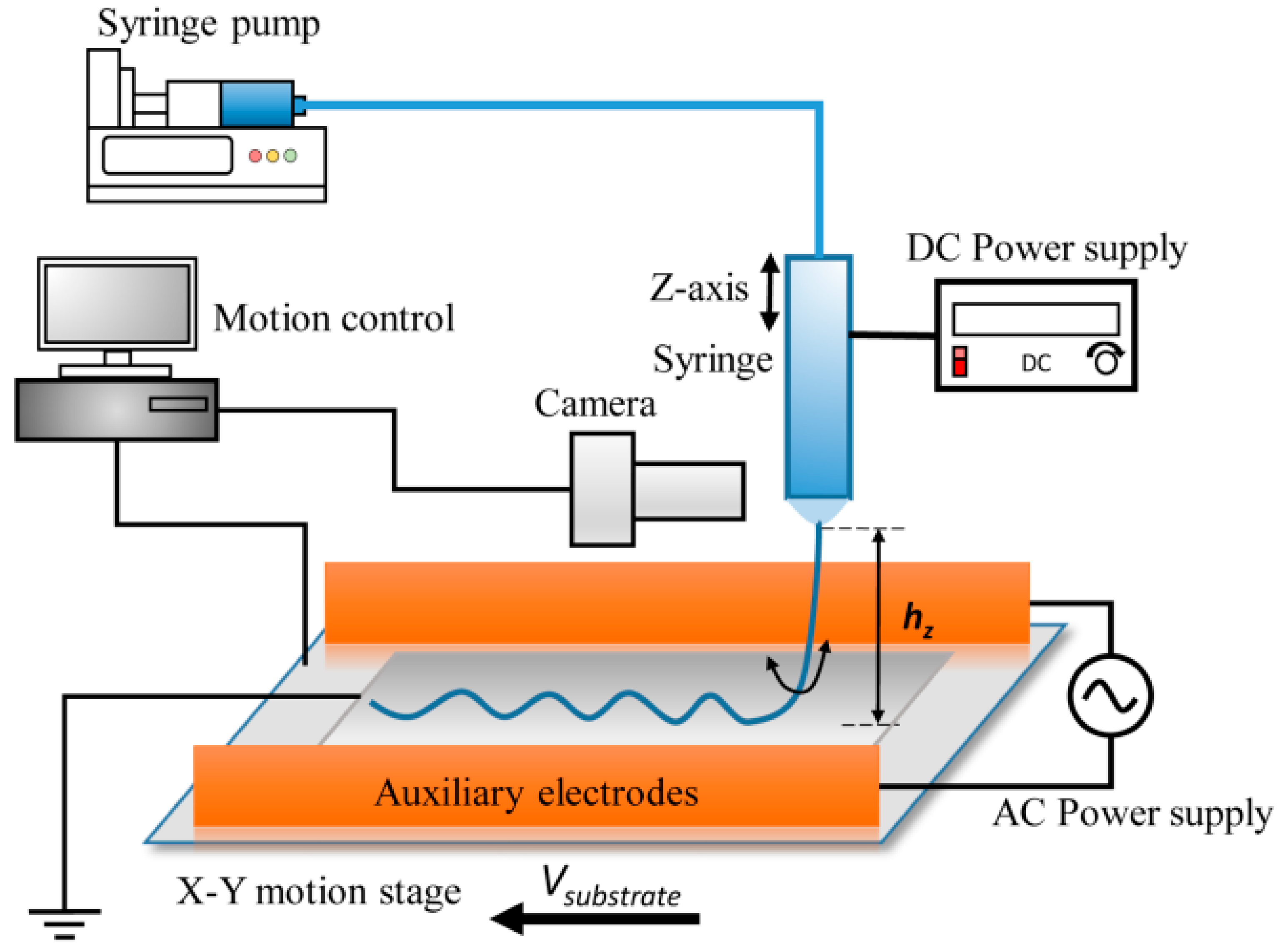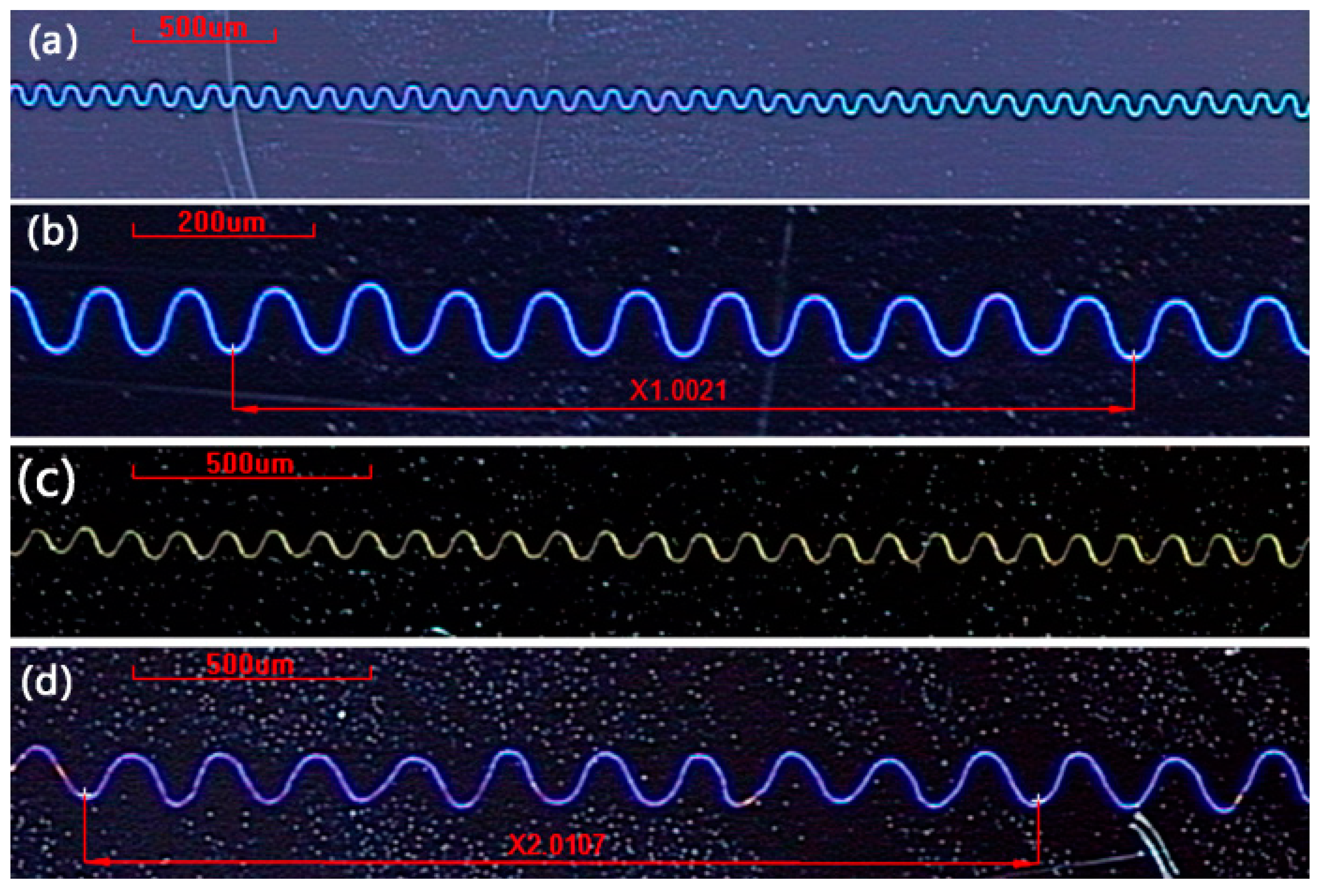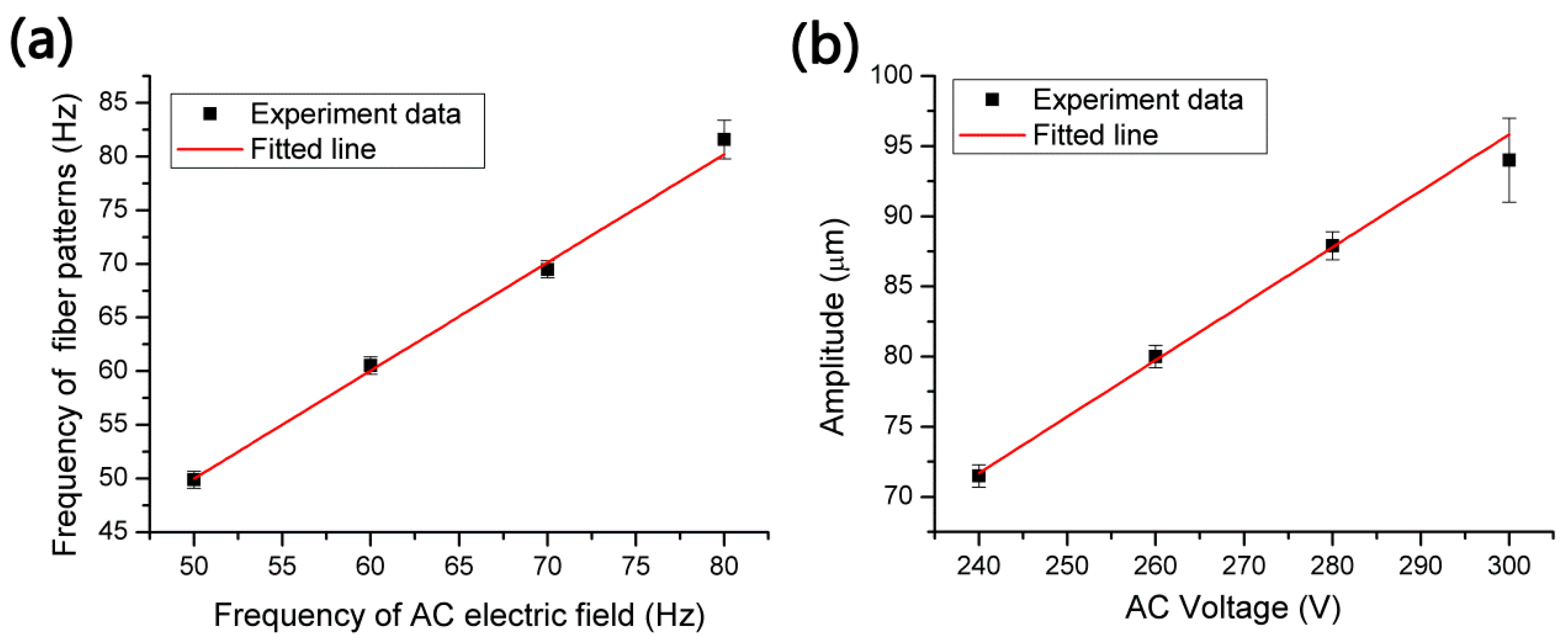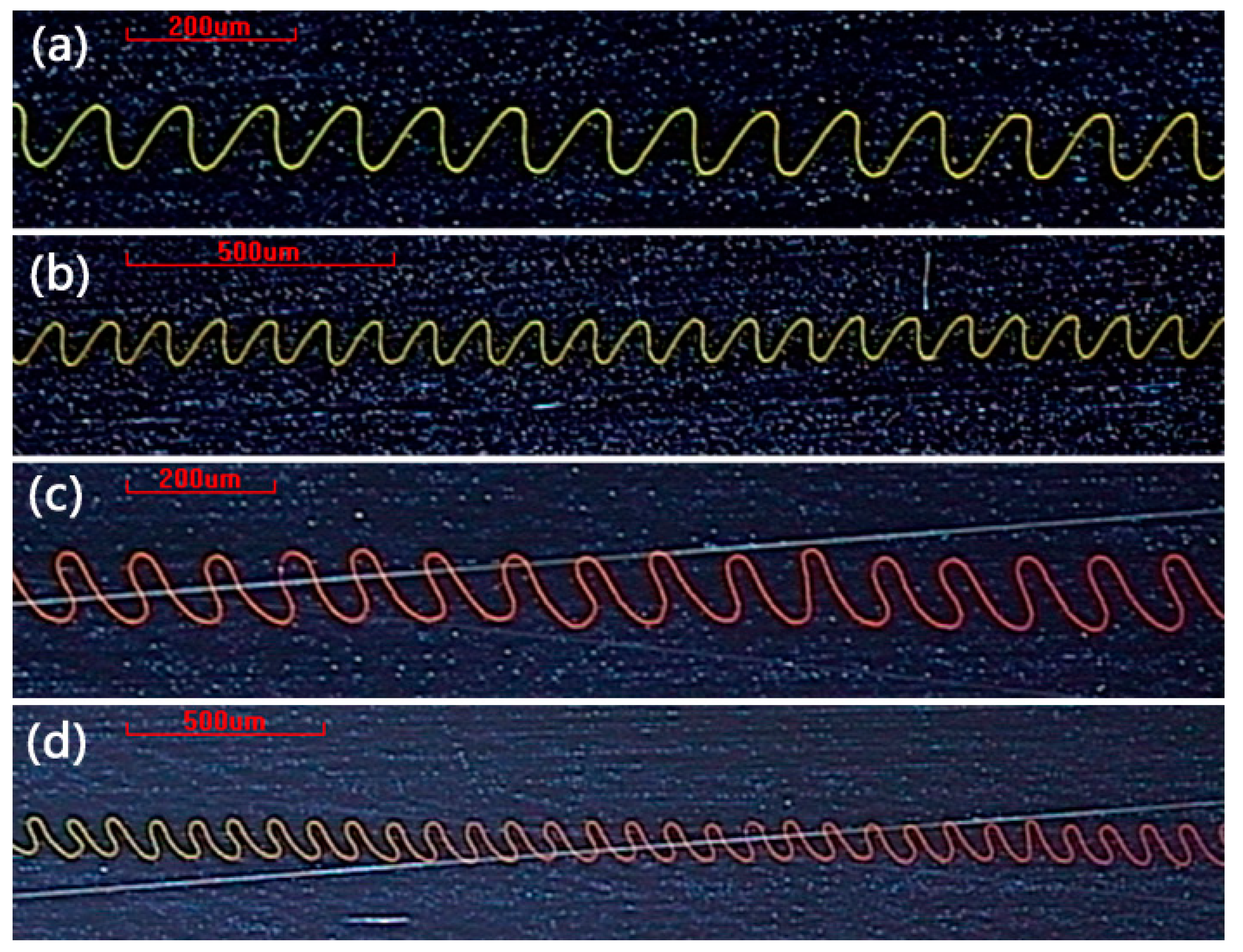Controllable Direct-Writing of Serpentine Micro/Nano Structures via Low Voltage Electrospinning
Abstract
:1. Introduction
2. Experimental Section

3. Results and Discussion


| Velocity of substrate | λ (μm) at AC 40 Hz | λ (μm) at AC 50 Hz | λ (μm) at AC 60 Hz | λ (μm) at AC 70 Hz |
|---|---|---|---|---|
| 5 mm/s | 125.16 | 100.21 | 83.53 | 71.58 |
| 8 mm/s | 200.39 | 160.34 | 133.50 | 114.55 |
| 12 mm/s | 301.60 | 241.28 | 201.07 | 171.98 |


4. Conclusions
Acknowledgments
Author Contributions
Conflicts of Interest
References
- Kim, D.H.; Lu, N.; Ma, R.; Kim, Y.S.; Kim, R.H.; Wang, S.; Wu, J.; Won, S.M.; Tao, H.; Islam, A.; et al. Epidermal electronics. Science 2011, 333, 838–843. [Google Scholar] [CrossRef] [PubMed]
- Song, Y.M.; Xie, Y.; Malyarchuk, V.; Xiao, J.; Jung, I.; Choi, K.J.; Liu, Z.; Park, H.; Lu, C.; Kim, R.H.; et al. Digital cameras with designs inspired by the arthropod eye. Nature 2013, 497, 95–99. [Google Scholar] [CrossRef] [PubMed]
- Xu, S.; Zhang, Y.; Cho, J.; Lee, J.; Huang, X.; Jia, L.; Fan, J.A.; Su, Y.; Su, J.; Zhang, H.; et al. Stretchable batteries with self similar serpentine interconnects and integrated wireless recharging systems. Nat. Commun. 2013, 4, 1543. [Google Scholar] [CrossRef] [PubMed]
- Yu, D.; Wang, S.; Ye, L.; Li, W.; Zhang, Z.; Chen, Y.; Zhang, J.; Peng, L.M. Electroluminescence from serpentine carbon nanotube based light emitting diodes on quartz. Small 2014, 10, 1050–1056. [Google Scholar] [CrossRef] [PubMed]
- Gutruf, P.; Walia, S.; Nur Ali, M.; Sriram, S.; Bhaskaran, M. Strain response of stretchable micro electrodes: Controlling sensitivity with serpentine designs and encapsulation. Appl. Phys. Lett. 2014, 104, 021908. [Google Scholar] [CrossRef]
- Tseng, A.A.; Chen, K.; Chen, C.D.; Ma, K.J. Electron beam lithography in nanoscale fabrication: recent development. IEEE Trans. Electron. Pack. Manuf. 2003, 26, 141–149. [Google Scholar] [CrossRef]
- Tseng, A.A. Recent developments in nanofabrication using focused ion beams. Small 2005, 1, 924–939. [Google Scholar] [CrossRef] [PubMed]
- Salaita, K.; Wang, Y.; Mirkin, C.A. Applications of dip pen nanolithography. Nature Nanotech. 2007, 2, 145–155. [Google Scholar] [CrossRef] [PubMed]
- Singh, M.; Haverinen, H.M.; Dhagat, P.; Jabbour, G.E. Inkjet printing process and its applications. Adv. Mater. 2010, 22, 673–685. [Google Scholar] [CrossRef] [PubMed]
- Park, J.U.; Hardy, M.; Kang, S.J.; Barton, K.; Adair, K.; Mukhopadhyay, D.K.; Lee, C.Y.; Strano, M.S.; Alleyne, A.G.; Georgiadis, J.G.; et al. High resolution electrohydrodynamic jet printing. Nat. Mater. 2007, 6, 782–789. [Google Scholar] [CrossRef] [PubMed]
- Di Benedetto, F.; Camposeo, A.; Pagliara, S.; Mele, E.; Persano, L.; Stabile, R.; Cingolani, R.; Pisignano, D. Patterning of light emitting conjugated polymer nanofibres. Nature Nanotech. 2008, 3, 614–619. [Google Scholar] [CrossRef] [PubMed]
- Camposeo, A.; Persano, L.; Pisignano, D. Light-Emitting electrospun nanofibers for nanophotonics and optoelectronics. Macromol. Mater. Eng. 2013, 298, 487–503. [Google Scholar] [CrossRef]
- Lee, S.W.; Lee, H.J.; Choi, J.H.; Koh, W.G.; Myoung, J.M.; Hur, J.H.; Park, J.J.; Cho, J.H.; Jeong, U. Periodic array of polyelectrolyte gated organic transistors from electrospun poly(3-hexylthiophene) nanofibers. Nano Lett. 2010, 10, 347–351. [Google Scholar] [CrossRef] [PubMed]
- Persano, L.; Dagdeviren, C.; Su, Y.; Zhang, Y.; Girardo, S.; Pisignano, D.; Huang, Y.; Rogers, J.A. High performance piezoelectric devices based on aligned arrays of nanofibers of poly(vinylidenefluoride co trifluoroethylene). Nat. Commun. 2013, 4, 1633. [Google Scholar] [CrossRef] [PubMed]
- Miao, Y.E.; Fan, W.; Chen, D.; Liu, T. High performance supercapacitors based on hollow polyaniline nanofibers by electrospinning. ACS Appl. Mater. Inter. 2013, 5, 4423–4428. [Google Scholar] [CrossRef] [PubMed]
- Dzenis, Y. Spinning continuous fibers for nanotechnology. Science 2004, 304, 1917–1919. [Google Scholar] [CrossRef] [PubMed]
- Bisht, G.S.; Canton, G.; Mirsepassi, A.; Kulinsky, L.; Oh, S.; Dunn Rankin, D.; Madou, M.J. Controlled continuous patterning of polymeric nanofibers on three dimensional substrates using low voltage near field electrospinning. Nano Lett. 2011, 11, 1831–1837. [Google Scholar] [CrossRef] [PubMed]
- Min, S.Y.; Kim, T.S.; Kim, B.J.; Cho, H.; Noh, Y.Y.; Yang, H.; Cho, J.H.; Lee, T.W. Large scale organic nanowire lithography and electronics. Nat. Commun. 2013, 4, 1773. [Google Scholar] [CrossRef] [PubMed]
- Sun, B.; Long, Y.Z.; Chen, Z.J.; Liu, S.L.; Zhang, H.D.; Zhang, J.C.; Han, W.P. Recent advances in flexible and stretchable electronic devices via electrospinning. J. Mater. Chem. C 2014, 2, 1209. [Google Scholar] [CrossRef]
- Sun, D.; Chang, C.; Li, S.; Lin, L. Near field electrospinning. Nano Lett. 2006, 6, 839–842. [Google Scholar] [CrossRef] [PubMed]
- Zheng, G.; Li, W.; Wang, X.; Wu, D.; Sun, D.; Lin, L. Precision deposition of a nanofibre by near–field electrospinning. J. Phys. D 2010, 43, 415501. [Google Scholar] [CrossRef]
- Huang, Y.; Duan, Y.; Ding, Y.; Bu, N.; Pan, Y.; Lu, N.; Yin, Z. Versatile, kinetically controlled, high precision electrohydrodynamic writing of micro/nanofibers. Sci. Rep. 2014, 4, 5949. [Google Scholar] [CrossRef] [PubMed]
- Xin, Y.; Reneker, D.H. Hierarchical polystyrene patterns produced by electrospinning. Polymer 2012, 53, 4254–4261. [Google Scholar] [CrossRef]
- Sun, B.; Long, Y.Z.; Liu, S.L.; Huang, Y.Y.; Ma, J.; Zhang, H.D.; Shen, G.; Xu, S. Fabrication of curled conducting polymer microfibrous arrays via a novel electrospinning method for stretchable strain sensors. Nanoscale 2013, 5, 7041–7045. [Google Scholar] [CrossRef] [PubMed]
- Yu, J.; Qiu, Y.; Zha, X.; Yu, M.; Yu, J.; Rafique, J.; Yin, J. Production of aligned helical polymer nanofibers by electrospinning. Eur. Polym. J. 2008, 44, 2838–2844. [Google Scholar] [CrossRef]
- Han, T.; Reneker, D.H.; Yarin, A.L. Buckling of jets in electrospinning. Polymer 2007, 48, 6064–6076. [Google Scholar] [CrossRef]
- Kessick, R.; Tepper, G. Microscale polymeric helical structures produced by electrospinning. Appl. Phys. Lett. 2004, 84, 4807. [Google Scholar] [CrossRef]
- Ding, Y.; Duan, Y.; Huang, Y.A. Electrohydrodynamically printed, flexible energy harvester using in situ poled piezoelectric nanofibers. Energy Technol. 2015, 3, 351–358. [Google Scholar] [CrossRef]
- Duan, Y.Q.; Huang, Y.A.; Yin, Z.P.; Bu, N.B.; Dong, W.T. Non-wrinkled, highly stretchable piezoelectric devices by electrohydrodynamic direct-writing. Nanoscale 2014, 6, 3289–3295. [Google Scholar] [CrossRef] [PubMed]
- Pagliara, S.; Camposeo, A.; Mele, E.; Persano, L.; Cingolani, R.; Pisignano, D. Enhancement of light polarization from electrospun polymer fibers by room temperature nanoimprint lithography. Nanotechnology 2010, 21, 966–971. [Google Scholar] [CrossRef] [PubMed]
- Persano, L.; Camposeo, A.; Pisignano, D. Active polymer nanofibers for photonics, electronics, energy generation and micromechanics. Prog. Polym. Sci. 2015, 43, 48–95. [Google Scholar] [CrossRef]
- Huang, S.; Zhao, C.; Pan, W.; Cui, Y.; Wu, H. Direct writing of half-meter long CNT based fiber for flexible electronics. Nano Lett. 2015, 15, 1609–1614. [Google Scholar] [CrossRef] [PubMed]
- Kuwayama, H.; Matsumoto, H.; Morota, K.; Minagawa, M.; Tanioka, A. Control over color of nanotextured coatings by electrospray deposition. Sen-Ito Kogyo 2008, 64, 1–4. [Google Scholar] [CrossRef]
- Matsapey, N.; Faucheu, J.; Flury, M.; Delafosse, D. Color effects of nanotextured aluminum surfaces: Characterization and modeling of optical behavior. Adv. Eng. Mater. 2014, 17, 45–51. [Google Scholar] [CrossRef]
© 2015 by the authors; licensee MDPI, Basel, Switzerland. This article is an open access article distributed under the terms and conditions of the Creative Commons Attribution license (http://creativecommons.org/licenses/by/4.0/).
Share and Cite
Fang, F.; Chen, X.; Du, Z.; Zhu, Z.; Chen, X.; Wang, H.; Wu, P. Controllable Direct-Writing of Serpentine Micro/Nano Structures via Low Voltage Electrospinning. Polymers 2015, 7, 1577-1586. https://doi.org/10.3390/polym7081471
Fang F, Chen X, Du Z, Zhu Z, Chen X, Wang H, Wu P. Controllable Direct-Writing of Serpentine Micro/Nano Structures via Low Voltage Electrospinning. Polymers. 2015; 7(8):1577-1586. https://doi.org/10.3390/polym7081471
Chicago/Turabian StyleFang, Feiyu, Xin Chen, Zefeng Du, Ziming Zhu, Xindu Chen, Han Wang, and Peixuan Wu. 2015. "Controllable Direct-Writing of Serpentine Micro/Nano Structures via Low Voltage Electrospinning" Polymers 7, no. 8: 1577-1586. https://doi.org/10.3390/polym7081471






